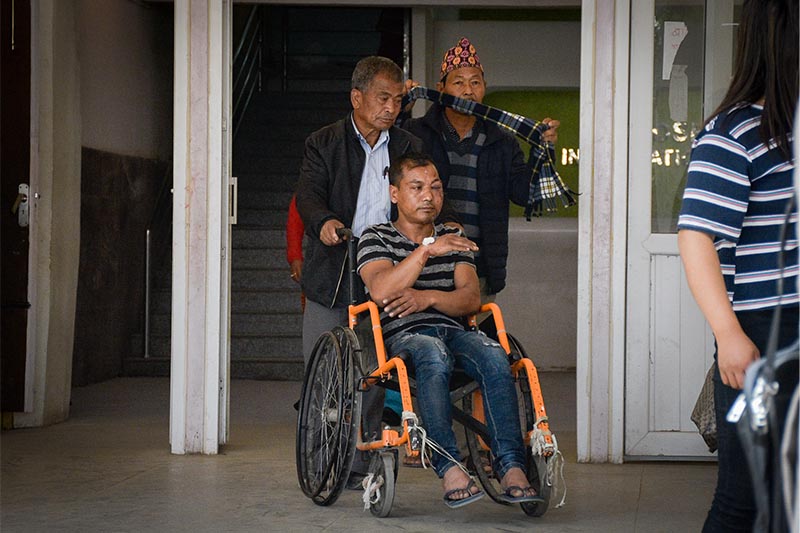Patients bear the brunt of doctors’ protest
Kathmandu, April 8
A corner at the main entrance of Bir Hospital has become the home of Akbar Ansari and his family since Saturday.
The 60-year-old from Sarlahi had visited the government-owned hospital in Kathmandu based on recommendation made by a hospice in Birgunj after severe pain in his left ankle did not subside. The labourer, who works in a sugarcane field, was hoping to get medical treatment on the day he arrived and return home immediately. But the hospital did not attend to him and asked him to return home. Reason: protest launched by government-hired doctors demanding that the federal government retain the authority to transfer them to provinces and local levels.
“We do not have enough money to stay in a hotel and we do not have money to return home and come back to Kathmandu either. So we have taken refuge here,” said Ansari, who has been sleeping under the sky, along with his family, on mattresses in a corner of the main entrance of Bir Hospital since their arrival in Kathmandu.
The protest launched by the Government Doctors’ Association of Nepal since Friday has severely affected patients like Ansari. The GODAN has been demanding that the federal government retain the authority to hire and transfer all doctors working in the country. The federal government, however, has transferred this authority to provincial and local governments as well following enactment of the Civil Servant Adjustment Act. The GODAN has been saying the permission granted to provincial and local governments to hire and transfer doctors will severely affect their career prospects as they will be restricted to certain provinces or municipalities.
The federal government, so far, has not shown any interest to amend the legal provision to address the demands of government-hired doctors. Neither have doctors provided signals to recall the protest. This means patients like Ansari who visit government-owned hospitals or primary healthcare centres will have to bear the brunt in the coming days as well.
The government operates 13 central-level hospitals, another 13 regional hospitals, 84 district-level hospitals and 209 primary healthcare centres. Around 200,000 patients visit these healthcare facilities every day. Since the protest was launched, the doctors have suspended all services, except emergency, hitting patients hard.
Kabala Pandey was supposed to undergo thigh bone surgery at the National Trauma Centre yesterday. But the 75-year-old patient from Dailekh has been asked to wait until Wednesday.
“We arrived in Kathmandu a month ago and were told to get admitted to the hospital 14 days ago,” said Pandey, who broke his thigh bone two years ago after slipping in toilet. “I had come to Kathmandu along with my son and his friend. My son is selling woollen carpets on the streets because we’ve run out of money.”
Seti Paudel, who broke her leg after slipping in kitchen, has a similar story to tell. The 70-year-old was supposed to undergo a surgery at the National Trauma Centre today but she doesn’t know how long she has to wait. The National Trauma Centre performs over 25 major and 50 minor surgeries every day. Most of them are general surgeries, neurosurgeries and surgeries related to eyes, nose and throat, orthopaedic and cardiothoracic, according to NTC Director Pramod Yadav. “We have not performed any surgery, except emergency, since Friday,” said Yadav.
Health Minister Upendra Yadav today threatened to act against protesting doctors if they did not return to work. He told this during an event held at the Nepal Health Research Council.
QUICK FACTS
- Doctors hired by the government: 1,400
- Number of primary healthcare centres: 209
- District hospitals: 84
- Regional and zonal hospitals: 13
- Central and tertiary hospitals: 13
- Doctors to be transferred to local levels: around 173
- Doctors to be transferred to provinces: around 300






